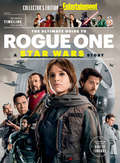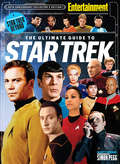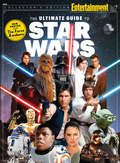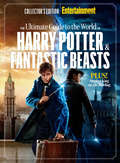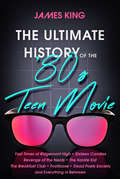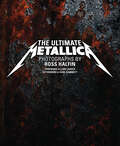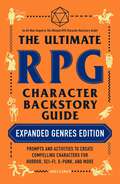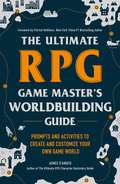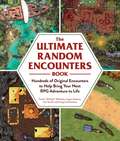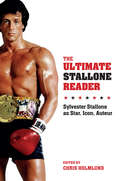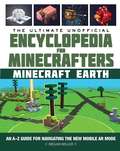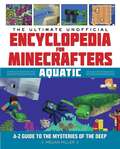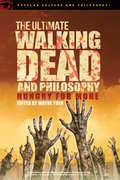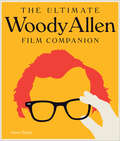- Table View
- List View
The Ultimate Guide to Rogue One: A Star Wars Story (Entertainment Weekly Collector's Edition)
by Gareth Edwards The Editors of Entertainment WeeklyThirty-nine years after the first Star Wars movie entranced audiences around the world comes Rogue One, the franchiseÍs first spinoff film. And now, to celebrate the arrival of a new chapter, Entertainment WeeklyÍs editors and writers bring you a collectorÍs edition that takes you deep inside the universe of Rogue One. The 96-page guide is packed with revealing new interviews with the cast; rarely seen photos of production, new characters, and creatures; and a timeline of the entire Star Wars saga. Extras for fans include:Foreword by director Gareth EdwardsMap of the Star Wars galaxyDeep dives on the Death Star, Darth Vader, and Stormtroopers
The Ultimate Guide to Star Trek (Entertainment Weekly Collector's Edition )
by Simon Pegg The Editors of Entertainment WeeklyYou may think you are already the ultimate Star Trek fan, but have you ever wondered how the Vulcan greeting came to be? Or who did (and didn't) get along behind the scenes of the USS Enterprise? Enter The Ultimate Guide to Star Trek, your personal guide to the shows, cast, crew and worlds that they explored. The Ultimate Guide to Star Trek chronologically explores the productions and fandom of Star Trek. We begin with the three-year run of the original series with stars William Shatner as Captain Kirk and Leonard Nimoy as Spock. Next we lead into the six major motion pictures of the 20th century and second generation of television series. Finally, we survey the current Star Trek major motion picture franchise with stars like Chris Pine and director J.J. Abrams. This 50th anniversary collector's edition includes new photos from the upcoming Star Trek Beyond movie and opens with an introduction by the film's cowriter and Scotty 2.0, Simon Pegg.
The Ultimate Guide to Star Wars
by Editors of Entertainment WeeklyA long time ago, in a galaxy far, far away... ten words changed the cinematic world forever. This heavily illustrated collector's edition covers the entire film universe of Star Wars, from A New Hope to The Force Awakens, and all the books, television shows, comics, and games in between. A celebration of the entire beloved franchise, this compendium features rarely seen production and cast photos from all the movies in the series; essays on Ralph McQuarrie, the founding of George Lucas's Industrial Light & Magic, director Irvin Kerschner, and more; as well as exclusive art and surprising reveals from Episode VII.
The Ultimate Guide to The Big Bang Theory
by The Editors of Entertainment WeeklyEntertainment Weekly Magazine presents The Ultimate Guide to The Big Bang Theory.
The Ultimate Guide to The Walking Dead (Entertainment Weekly Collector's Edition)
by Chris Hardwick The Editors of Entertainment WeeklyWalking Deadheads. Either you are one or you know one. Now in its seventh season, "The Walking Dead" has gone from cult hit to cultural movement and has now achieved the status of appointment television. Mostly because of one simple word - community: This is a show about a tight community made by a tight community for a tight community, and part of its simple appeal is that it makes us face the most basic questions about who we'd become in an extreme world, and who would be there with us.Now, in an all-new collector's edition, Entertainment Weekly takes readers into the writing room, behind the scenes and onto the sets in The Ultimate Guide to The Walking Dead. Go inside each season with exclusive photographs, interviews with the cast and crew, a season-by-season recap, as well as original art that traces the journey of survivors in the series, created by the artists who draw The Walking Dead comic books. Additionally, this collector's edition has two front covers, one of the living, and one of the undead (you should probably collect them both!).With exclusive insights into season 7, special sidebars, as well as an original essay on Why We Love Zombies, The Ultimate Guide to The Walking Dead is the drop un-dead companion to one of the hottest shows on television today.
The Ultimate Guide to the World of Harry Potter & Fantastic Beasts (Entertainment Weekly Collector's Edition)
by Stephen King The Editors of Entertainment WeeklyFrom The Sorcerer's Stone to Fantastic Beasts and Where to Find Them, J. K. Rowling's never ending world of enchantment has charmed a generation. Now, from the editors of Entertainment Weekly comes the spellbinding tale of how a beloved children's book series became a blockbuster movie franchise, and more. This ultimate guide is stuffed with all the need-to-know details about Rowling's long-awaited return to the wizarding world with Fantastic Beasts, a review of the Cursed Child play, a heartfelt farewell to the actor who played Severus Snape, and eye-opening behind-the-scenes images and quotes from the cast and crew of all the movies. Featuring Scoops from the set of Beasts, plus interviews with the cast, crew, and director of the highly anticipated new film, a foreword by Stephen King exploring Rowling's ability to turn kids into readers, a where-are-they-now feature on the Potter cast, including interviews with Daniel Radcliffe, Emma Watson, and Rupert Grint,
The Ultimate History of the '80s Teen Movie: Fast Times At Ridgemont High ~ Sixteen Candles ~ Revenge Of The Nerds ~ The Karate Kid ~ The Breakfast Club ~ Footloose ~ Dead Poets Society ~ And Everything In Between
by James KingFor fans of The Movies That Made Us, a behind-the-scenes look at what went into making the favorite blockbuster films of the 1980s. A trip back to the era of troubled teens and awesome soundtracks; of Reagan, rap, and Ridgemont High; of MTV, VHS, and &“Axel F&”; of outsiders, lost boys, and dead poets; of Bill and Ted, Brooke Shields, and the Brat Pack; of three Porky&’s flicks, two Coreys, and one summer when &“Baby&” refused to be put in a corner.The Ultimate History of the &’80s Teen Movie goes behind the scenes of a genre where cult hits mingled with studio blockbusters, where giants like Spielberg and Coppola rubbed shoulders with baby-faced first-timers, and where future superstars Sean, Demi, and Tom all got their big break. Music, comedy, and politics all play a part in the surprisingly complex history of the &’80s teen movie. And while the films might have been aimed primarily at adolescents, the best tackle universal issues and remain relevant to all ages. From a late &’70s Hollywood influx to an early &’90s indie scene that gave youth cinema a timely reboot, film expert James King highlights the personal struggles, the social changes, and the boardroom shake-ups that produced an iconic time in movie history.&“Admirably opting for analysis over nostalgia and gossip, King examines the origin, production, and cultural afterlife of seemingly every youth-centric 1980s movie you've ever heard of and more . . . An excellent adventure through a distinct and genre-spanning era in cinema history. For casual movie fans and industry-minded cinephiles alike.&” —Library Journal
The Ultimate Metallica: 0
by Kirk Hammett Ross HalfinOver 250 photos of the band by their top photographer—plus reminiscences by managers, music writers, and members of Metallica themselves.Legendary music photographer Ross Halfin has documented Metallica from their beginnings as a scrappy, furious garage band to their current status as the heaviest and most popular metal band in the world. The Ultimate Metallica collects the best of Halfin’s amazing images, taken over the years with access granted exclusively to him as the band’s main lensman. His candid photographs—taken on stage, backstage, on and off tour—are supplemented by text from many people close to the band, including managers and music writers, plus some colorful personal observations from Halfin himself.“Ross Halfin’s mark is often imprinted when I access the Metallica memory bank, located deep in the bowels of my thick Danish skull.” —Lars Ulrich
The Ultimate Micro-RPG Book: 40 Fast, Easy, and Fun Tabletop Games (Ultimate Role Playing Game Series)
by James D’AmatoEnjoy these 40 expertly crafted micro-RPGs that are fast, fun, easy to learn, and come in a variety of genres—from space exploration to jungle dungeon crawlers—everything you need to pick up and play today. Get gaming fast with The Ultimate Micro-RPG Book including brand-new micro-RPGs created by experts across the gaming world. From space exploration to jungle dungeon crawlers this book has everything you need to pick up and play today. With these quick-start games, you can create your own adventures, alone or with friends, without any prep, and with minimal set up and pieces. Whether you&’re new to RPGs or working towards your level 20 mage, this collection is a great way to try out different games and systems, and test your roleplay skills on different character types and situations.
The Ultimate RPG Character Backstory Guide: Prompts and Activities to Create Compelling Characters for Horror, Sci-Fi, X-Punk, and More (Ultimate Role Playing Game Series)
by James D’AmatoTake your skyship pirate, haunted waif, or alien scientist to the next level with this fun, interactive book of exercises to help you build your RPG character&’s backstory—made specifically for the genres you love to play.You can now explore new RPG character ideas with this character backstory guide to the most popular RPG genres beyond fantasy, from sci-fi to horror and superhero to western-themed games. This latest guide from One Shot creator and RPG expert James D&’Amato helps you build out an existing character or create a new one, with these activities that provide plenty of RPG fun before you even hit the gaming table. With activities to help you flesh out characters for fantasy, sci-fi, horror, x-punk, superhero and western campaigns (with an extra chapter of neutral exercises you can use whenever you like), this book has everything you need, whether you&’re looking to start a new character, build out an existing character you&’re currently playing, or explore new character ideas and genres.
The Ultimate RPG Game Master's Worldbuilding Guide: Prompts and Activities to Create and Customize Your Own Game World (The Ultimate RPG Guide Series)
by James D’AmatoLevel up your Game Master skills with these fun, interactive prompts and activities to help your worldbuilding from RPG expert James D&’Amato.Make your next campaign truly unique with the help of this interactive guide to world building! From RPG expert James D&’Amato comes a fun new guide that teaches beginner and experienced gamers alike how to build and create their own game elements for customizing existing adventures or creating new stories from scratch. The Ultimate RPG Game Master&’s Worldbuilding Guide includes dozens of activities for a wide range of genres from fantasy and sci-fi to horror and x-punk. This lively and interactive book helps Game Masters create dynamic destinations, powerful items, shadowy organizations, compelling villains, and more. Make the most of your gaming experience with these unique and personalized ideas for your gaming group&’s next adventures!
The Ultimate RPG Guide Boxed Set: Featuring The Ultimate RPG Character Backstory Guide, The Ultimate RPG Gameplay Guide, and The Ultimate RPG Game Master's Worldbuilding Guide (The Ultimate RPG Guide Series)
by James D’AmatoA Simon & Schuster eBook. Simon & Schuster has a great book for every reader.
The Ultimate Random Encounters Book: Hundreds of Original Encounters to Help Bring Your Next RPG Adventure to Life (The Ultimate RPG Guide Series)
by Travis "Wheels" Wheeler Logan Jenkins Lee Terrill Greg LeathermanTake your gaming campaign to the next level with this inspiring, easy-to-use collection of random encounters perfect for any fantasy RPG.Spark your imagination fast with this collection of fun, engaging, and inspiring random encounter prompts. These expertly written options are organized into popular themes and locations so you can find what you need fast, whether you choose from the list or use the dice to choose randomly. With fantasy hooks to fit every game from Pathfinder to GURPS to D&D, there are options for all of your campaigns. Whether you&’re playing from a game book or weaving your own homebrewed adventure, there&’s always a need for short random encounters in between set pieces. Featuring fun full-color illustrations, you&’ll engage more in your story and bring your game to life!
The Ultimate Stallone Reader
by Chris HolmlundSylvester Stallone has been a defining part of American film for nearly four decades. He has made an impact on world entertainment in a surprisingly diverse range of capacities -- as actor, writer, producer, and director -- all while maintaining a monolithic presence. With The Ultimate Stallone Reader, this icon finally receives concerted academic attention. Eleven original essays by internationally-known scholars examine Stallone's contributions to mainstream cinema, independent film, and television. This volume also offers innovative approaches to star, gender, and celebrity studies, performance analysis, genre criticism, industry and reception inquiry, and the question of what it means to be an auteur. Ultimately, The Ultimate Stallone Reader investigates the place that Sylvester Stallone occupies within an industry and a culture that have both undergone much evolution, and how his work has reflected and even driven these changes.
The Ultimate Stallone Reader: Sylvester Stallone as Star, Icon, Auteur
by Ed. Chris HolmlundSylvester Stallone has been a defining part of American film for nearly four decades. He has made an impact on world entertainment in a surprisingly diverse range of capacities – as actor, writer, producer, and director – all while maintaining a monolithic presence. With The Ultimate Stallone Reader, this icon finally receives concerted academic attention. Eleven original essays by internationally-known scholars examine Stallone's contributions to mainstream cinema, independent film, and television. This volume also offers innovative approaches to star, gender, and celebrity studies, performance analysis, genre criticism, industry and reception inquiry, and the question of what it means to be an auteur. Ultimately, The Ultimate Stallone Reader investigates the place that Sylvester Stallone occupies within an industry and a culture that have both undergone much evolution, and how his work has reflected and even driven these changes.
The Ultimate Unofficial Coronation Street Quiz
by Ed CobhamSo you think you're one of Corrie's biggest fans? Test your knowledge with this trivia quiz book. What faulty household item caused the death of Valerie Barlow in 1971? Who died after being run over by a Blackpool tram in 1989? If you’re more at home in The Rovers than anywhere else, these brain-teasing questions will be right up your street!
The Ultimate Unofficial Coronation Street Quiz
by Ed CobhamSo you think you're one of Corrie's biggest fans? Test your knowledge with this trivia quiz book. What faulty household item caused the death of Valerie Barlow in 1971? Who died after being run over by a Blackpool tram in 1989? If you’re more at home in The Rovers than anywhere else, these brain-teasing questions will be right up your street!
The Ultimate Unofficial Eastenders Quiz Book
by Ed CobhamSo you think you're one of Eastenders' biggest fans? Test your knowledge with this trivia quiz book:How many times has Sharon been married? What colour was the original exterior of the Queen Vic? If you think you’re practically a resident of the square, these brain teasing questions will drive you Dotty until you've got them all!
The Ultimate Unofficial Eastenders Quiz Book
by Ed CobhamSo you think you're one of Eastenders' biggest fans? Test your knowledge with this trivia quiz book:How many times has Sharon been married? What colour was the original exterior of the Queen Vic? If you think you’re practically a resident of the square, these brain teasing questions will drive you Dotty until you've got them all!
The Ultimate Unofficial Encyclopedia for Minecrafters: An A–Z Guide to Unlocking Incredible Adventures, Buildplates, Mobs, Resources, and Mobile Gaming Fun (Encyclopedia for Minecrafters)
by Megan MillerFrom the New York Times bestselling author Megan Miller comes this crucial guide to navigating Minecraft&’s AR game play mode! What do a muddy pig, a moobloom, and a minecoin have in common? They&’re all featured in Minecraft Earth and they&’re all in the M section of this easy-to-use encyclopedia for gamers of all ages. The Ultimate Unofficial Encyclopedia for Minecrafters: Earth covers everything from A to Z, from Adventure loot chests to zombies, giving Minecraft fans the ability to transform their own neighborhood into an incredible Minecraft playground. All you need is a mobile phone or tablet and this user-friendly guide. You&’ll learn how to: Use the overworld map to find tappables and get all the resources you needEnter Minecraft Adventures where you can solve challenges and battle hostile mobs with friends!Create unique masterpieces using build plates in tabletop or life-size view modeLocate and identify the best resources in the gameCollect and breed rare mobsFarm, craft, and battle with more successAvoid the pitfalls noobs make when playing Minecraft Earth Armed with this helpful guide to all the resources, mobs, and features that Minecraft Earth has to offer, you'll be ready to fight, craft, mine, and play with the best of them.
The Ultimate Unofficial Encyclopedia for Minecrafters: An A–Z Guide to the Mysteries of the Deep (Encyclopedia for Minecrafters)
by Megan MillerFrom the New York Times bestselling author of Hacks for Minecrafters comes a whole new encyclopedia on the underwater world of Minecraft! What's a Red-Lipped Blenny? How can you find more buried treasure? Where do you find blue ice, and why is it valuable? For Minecraft knowledge hunters, ocean animal-lovers, and adventurers ready for the Minecraft life aquatic, this encyclopedia of the underwater world of Minecraft is a game-changing resource. Find out all you need know in this easy-to-use, A to Z, illustrated encyclopedia covering everything from anemones to underwater zombies. You&’ll learn how to: Build an aquariumActivate a conduitFind the precious Heart of the SeaUse dolphins to uncover shipwrecks and other underwater ruinsAnd more! Armed with this helpful guide to all the resources the sea has to offer, you'll be ready to fight, craft, mine, and thrive in the watery depths of Minecraft with The Ultimate Unofficial Encyclopedia for Minecrafters: Aquatic.
The Ultimate Walking Dead and Philosophy
by Wayne YuenIn The Walking Dead, human beings are pushed to their limits by a zombie apocalypse and have to decide what really matters. <P><P>Good and evil, freedom and slavery, when one life has to be sacrificed for another, even the nature of religion-all the ultimate questions of human existence are posed afresh as the old society crumbles away and a new form of society emerges, with new beliefs and new rules. The Ultimate Walking Dead and Philosophy brings together twenty philosophers with different perspectives on the imagined world of this addictive TV show. How can we keep our humanity when faced with such extreme life-or-death choices? Did Dr. Jenner do the right thing in committing suicide, when all hope seemed to be lost? Does the Governor, as the new Machiavelli, prove that willingness to repeatedly commit murder is the best technique for getting and keeping political power? Why do most characters place such importance on keeping particular individuals alive, especially children? What can we learn about reality from Rick's haunting hallucinations?
The Ultimate Woody Allen Film Companion
by Jason BaileyA complete look at the extensive, ageless, unparalleled filmography of Woody Allen. Writer, actor, director, comedian, author, and musician, Woody Allen is one of the most culturally and cinematically influential filmmakers of all time. His films - he has over 45 writing and directing credits to his name - range from slapstick to tragedy, farce to fantasy. As one of history's most prolific moviemakers, his style and comic sensibility have been imitated, but never replicated, by countless other filmmakers over the years. In The Ultimate Woody Allen Film Companion, film writer Jason Bailey profiles every one of Allen's films: from his debut feature, What's Up, Tiger Lily, through slapstick classics such as Take the Money and Run and Sleeper; Academy Award-winning films such as Annie Hall and Hannah and Her Sisters; and recent gems such as Midnight in Paris and Blue Jasmine. Bailey also includes essays on the fascinating themes that color Allen's works, from death and Freud to music and New York City. Getting up close and personal with the actors and actresses that have brought the iconic films to life, this book's behind-the-scenes stories span the entire career of a man whose catalog has grown into a timeless cornerstone of American pop culture. Complete with full cast lists, production details, and full-color images and artwork, The Ultimate Woody Allen Film Companion is the ultimate, indispensable reference to one of cinema's most beloved and important figures.
The Ultimate: The Great American Arguments Settled Once and for All
by William PoundstoneThe Ultimate is sophisticated fun, literate trivia in the witty, anecdotal and provocative style familiar to Poundstone fans across the country. Here Poundstone establishes objective ways of determining what really is the biggest, the highest, the greatest, and the best.
The Unauthorized History of DX (WWE)
by Shawn Michaels Triple HThe inside story of DX, otherwise known as, D Generation-X, from their formation to today told by the men who created it.DX is generally considered one of the most popular factions in professional wrestling history, not to mention, one of the most notable. D-Generation X, as they were also known, headed by Triple H and Shawn Michaels and had a changing roster of rebels who did whatever they wanted, whenever, wherever- regardless of the ultimate outcome. Created as a way for two friends to work together, the clique became so popular that other wrestlers joined, and DX became one of the factions in WWE climbing back to the top and putting Ted Turner's WCW out of business.
